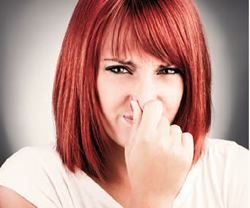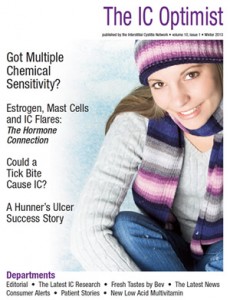Are You Sensitive?
By Jill Osborne MA – (Adapted from Osborne J. Got Multiple Chemical Sensitivity. IC Optimist, Winter 2013, p.5-10)
 Do you have a powerful sense of smell? Can you smell things in your home that your family members can’t smell? Do smells bother or hurt you? If you answered yes, you’re like the majority of IC patients who have contacted the ICN in the past twenty years. When asked if they have a sensitive sense of smell, most laugh loudly and then ask “How could you possibly know that?” It’s as if our bodies react to smells and chemicals differently and, speaking from personal experience, some can make us quite ill.
Do you have a powerful sense of smell? Can you smell things in your home that your family members can’t smell? Do smells bother or hurt you? If you answered yes, you’re like the majority of IC patients who have contacted the ICN in the past twenty years. When asked if they have a sensitive sense of smell, most laugh loudly and then ask “How could you possibly know that?” It’s as if our bodies react to smells and chemicals differently and, speaking from personal experience, some can make us quite ill.
I have been sensitive to smells from chemicals for most of my life. I have never been able to tolerate the use of polyurethanes and wood stains in my home because they trigger intense pain and nausea. Room sprays (i.e. Febreze), scented candles and even some soaps cause sinus congestion and, often, waves of dizziness and vertigo. The use of strong cleansers such as bleach or oven cleaner requires multiple fans that direct the air out of the house immediately. I have a classic case of multiple chemical sensitivity.
The National Institute of Environmental Health Sciences (a division of the NIH) defines multiple chemical sensitivity (MCS) as a “chronic, recurring disease caused by a person’s inability to tolerate an environmental chemical or class of foreign chemicals.” (1) Symptoms can include nausea, fatigue, dizziness and headaches, as well as inflammation of skin, joints, gastrointestinal tract and airways.
MCS is a controversial diagnosis because few studies have been conducted to understand its cause and effect. Yet, for those patients who suffer, there is no doubt that this is a real condition. The most common offenders are wood stains, pesticides, plastics, synthetic fabrics, petroleum products, and paint fumes. Chemicals that most people
would assume as benign, such as a scented oil used in candles or electric air fresheners, release volatile organic compounds (VOC’s) some of which have been found to cause cancer or developmental problems. Patients with sensitive skin report burning from perfumed bath oils or salts, various scented soaps and scented laundry products.
Gaye Sandler, the author of Patient to Patient: Managing IC and Overlapping Conditions was the first to discuss the connection between IC and multiple chemical sensitivity. In 2000, she wrote “A number of interstitial cystitis patients experience sensitivity to fragrances and scented products, and occasionally experience bladder symptoms
when they are exposed to gasoline fumes, paints and certain chemicals.” (2) Patients who suffer from many of the related conditions to IC, such as low thyroid, fibromyalgia and mitral valve prolapse, also share greater chemical sensitivity.
Could chemical exposure contribute to the development of IC and/or bladder symptoms? There is compelling supporting evidence. Researchers throughout the world have confirmed that ketamine, a recreational drug, is so damaging to the urinary tract that, if used over time, the bladder becomes ulcerated. Chemotherapy can cause create bladder irritation, known as chemo-induced cystitis. Of course, many chemicals found in food, such as artificial sugars, dyes & some preservatives, are notorious for trigger bladder irritation and IC flares.
I was shocked to read that one strongly related condition to IC, endometriosis, has now been conclusively linked to the exposure of dioxin, considered the most toxic chemical known to science. This was first discovered in a dioxin toxicity study using monkeys most of whom developed endometriosis, the severity of which correlated directly with increased levels of dioxin exposure.(3)
A bi-product of waste incineration and the paper industry, dioxin is well known for its ability to damage the immune system and interfere with hormonal systems. It has been linked to birth defects, inability to maintain pregnancy, decreased fertility, reduced sperm counts, diabetes, learning disabilities, immune system suppression, lung problems, skin disorders, lowered testosterone levels and more. Tragically, most of our exposure to dioxin comes from the foods that we eat. Dioxin is fat-soluble, thus bioaccumulates up the food chain where it is found most frequently in meat, fish and dairy products.
Kim Collier MA, author of “Endometriosis and Chronic Fatigue Immune Dysfunction Syndrome: Two Sides of the Same Coin?” suggests that the human body cannot properly metabolize and eliminate toxins adequately. She wrote “There comes a point in our lives when our exposure to chemicals, viruses or inhalants exceeds our body’s ability to manage them and, as a result, our health begins to decline. This is often seen as “the straw” that “breaks” the backs of our delicate bodies.” (4)
Sherry Rogers MD, in her book Tired or Toxic? believes that chemical exposure may be the root for a number of systemic illnesses such as endometriosis and CFIDS. She suggests that repeated exposure to chemicals is so disruptive to our bodies natural processes that it can lead to immune and endocrine abnormalities which the endometriosis and dioxin research has now proven. The challenge in reducing our exposure is that many chemicals are stored in fatty tissue, often for years.
Endometriosis was considered rare in the early 1980’s. Today, more than 7.5 million women and girls in North America suffer from endometriosis with millions more around the world.(6) We’ve seen similar growth in IC with more than 3 to 8 million women and 4 million men now believed to have symptoms of IC.
Deborah Metzger MD was the first clinician and researcher to suggest that IC could be triggered by a chemical exposure or stressor. She said “You can expose five different women to the same stressors, and one will develop the primary symptoms of endometriosis, another chronic fatigue syndrome, another interstitial cystitis, another irritable bowel, and another fibromyalgia. What becomes the primary complaint in these women (pelvic pain, GI problems, fatigue, etc.) is an indicator of the systems that were most vulnerable to trauma and stressors…”(7)
Can we conclusively say that IC is caused by a chemical exposure. Certainly NOT at this time. However, it is clear that a variety of chemicals in our daily lives have the ability to cause cancer, infertility and a host of other medical complaints. The silent victims, of course, are our children.
References:
- MCSS factsheet – United States National Institute of Environmental Health Sciences
- Sandler G, et al. Patient to Patient: Managing Interstitial Cystitis & Overlapping Conditions. Bon Ange LLC. 2000 p.95
- Sherry E. Rier and others, “Endometriosis in Rhesus Monkeys (MACACA MULATTA) Following Chronic Exposure to 2,3,7,8-Tetrachlorodibenzo-Pdioxin,” FUNDAMENTAL AND APPLIED TOXICOLOGY Vol. 21 (1993), pgs. 433-441.
- Collier K, et al. “Endometriosis and chronic fatigue immune dysfunction syndrome; two sides of the same coin?” Endometriosis Association Newsletter Volume 25, No. 3-4, p2-14
- Endometriosis Fact Sheet – Endometriosis Association – Accessed 2/10/13 – http://www.endometriosisassn.org/endo.html
- Dahl L. “Toxic Couture” Safer Chemicals Healthy Families Blog. February 11, 2013.
- Sandler G. et al. Patient to Patient: Managing IC and Related Conditions. Bon Ange LLC 2000 p. 05
[break] [hr] [break]
Reducing Chemical Exposure
A number of experts and patient groups, such as the Endometriosis Association, strongly advise patients to reduce their exposure to toxic chemicals. I believe these same recommendations should be applied by IC patients. The challenge, of course, is their pervasiveness in our daily lives. Several websites can help.
- How To Reduce Toxic Chemicals In Your Home
- EWG Shoppers Guide to Pesticides in Produce – Products high and low in residual pesticides
- Toxic Free Furniture On The Horizon

